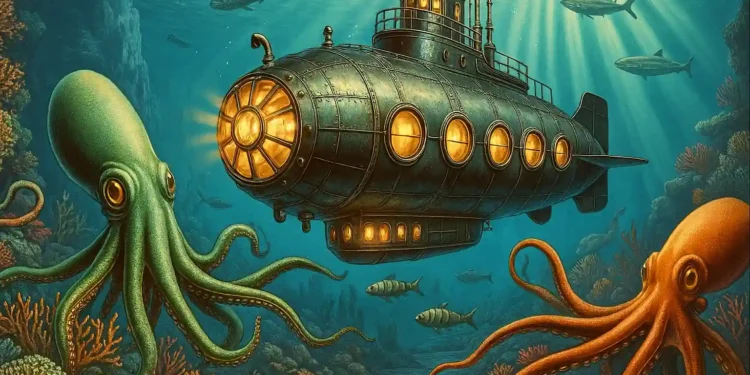The predictions Jules Verne made about the future are some of the most astonishing in literary history. More than a century ago, Jules Verne imagined technologies and social shifts that would take humanity decades — even centuries — to realize. His novels didn’t just entertain; they foresaw electric submarines, space travel, video calls, and global media long before these ideas entered public consciousness.
Through visionary novels like Twenty Thousand Leagues Under the Sea, From the Earth to the Moon, and Journey to the Center of the Earth, Verne anticipated many of the tools, systems, and scientific breakthroughs we take for granted today. These are the most remarkable predictions Jules Verne made about the future, and how they came true — sometimes in ways even he couldn’t have expected.
Paris in the Twentieth Century: Cars, Skyscrapers, and a Global Network
In 1863, Verne wrote a novel so ahead of its time that his publisher refused to release it. It wasn’t until 1994 — over a century later — that Paris in the Twentieth Century was finally published.
In it, Verne imagined a futuristic city filled with:
-
Gas-powered cars
-
High-speed trains
-
Glass skyscrapers
-
An international communications network eerily similar to today’s internet
He also foresaw a hyper-efficient, industrialized society where the arts were neglected, education was highly technical, and people lived under the influence of vast corporations — themes that feel strikingly relevant today.
The Nautilus: Electric Submarines and Marine Science
When I think about all the predictions Jules Verne made about the future, this perhaps is my favorite. Verne’s Twenty Thousand Leagues Under the Sea introduced the world to the Nautilus, an all-electric submarine powered by lead-acid batteries. At a time when submarines barely functioned, Verne described one with:
-
Luxurious interiors
-
Self-sustaining power
-
Long-term underwater habitation
Today, electric submarines like the Alvin and deep-sea exploration vessels mirror much of what Verne envisioned — including the importance of oceanography and marine biology, fields he helped inspire with vivid storytelling and scientific imagination.
In the Year 2889: Newscasts, Podcasts, and Media Evolution
In his short story In the Year 2889, Verne predicted the future of news. Instead of printed papers, he described:
-
Spoken news reports delivered to subscribers — decades before the first radio broadcasts
-
Photographs as a key component of journalism
-
A media-dominated culture where communication defined public life
His idea of audio news now lives on in podcasts, live news streaming, and voice-delivered media.
A Sea Beneath the Earth’s Surface?
Journey to the Center of the Earth offered a thrilling — if imaginative — theory: a vast underground ocean hidden within the Earth. While no such ocean exists in liquid form, modern geoscience has discovered water molecules trapped in rock deep within the mantle.
These findings don’t validate Verne’s vision directly, but they show he was tapping into a genuine curiosity about the unknown layers beneath our feet.
Light-Propelled Spacecraft, Animal Test Flights, and Solar Sails
In 1865, Verne described light-propelled spaceflight in From the Earth to the Moon. NASA and other agencies are now actively experimenting with solar sails, spacecraft powered by sunlight.
He also described:
-
Spacecraft carrying animals — decades before Laika, the Soviet space dog, made history in 1957
-
Detailed lunar modules
-
Human crews in space — long before the first manned flights
His fictional technology wasn’t just believable — it often mirrored the concepts used in real space programs a century later.
Apollo XI and Verne’s Spacecraft: The Columbia Connection
Verne’s spacecraft in From the Earth to the Moon was called Columbia — just like the Apollo XI command module.
And the similarities don’t stop there:
-
Both were made of aluminum
-
Both carried three astronauts
-
Both had conical shapes
-
Both launched from the United States and splashed down in the ocean
Verne even got the physics right: the speed needed to escape Earth’s gravity, the ballistics of the trajectory, and the ideal launch location — which he placed just 100 kilometers from where Cape Canaveral would later be built.
Law Enforcement Tech and Futuristic Communication
Verne also made predictions in other areas of public life:
-
In In the Year 2889, he described atmospheric advertising — similar to today’s skywriting
-
He invented the phonotelephote, a device for real-time visual communication — essentially video calling
-
In Twenty Thousand Leagues Under the Sea, he wrote about an electric shock gun — very similar to modern Tasers used by law enforcement
More than fiction — a vision of what could be
The predictions Jules Verne made about the future weren’t always perfect, but they were rooted in logic, science, and observation. He saw where technology was heading — and accelerated it with imagination.
His works continue to inspire scientists, writers, engineers, and dreamers alike. And in a world where reality increasingly echoes fiction, Jules Verne remains one of the most prescient voices in literary history.











